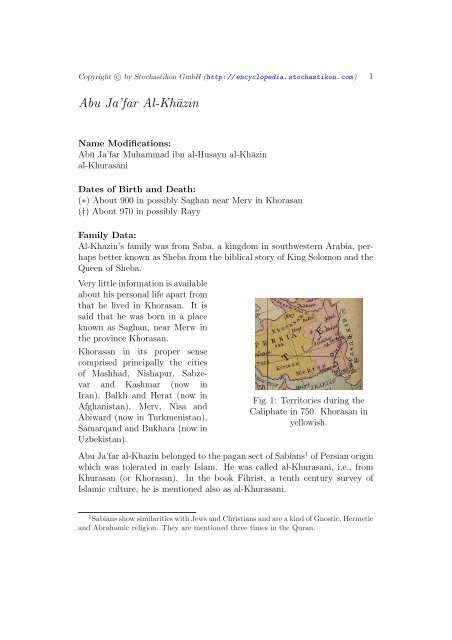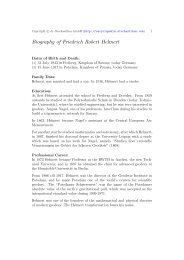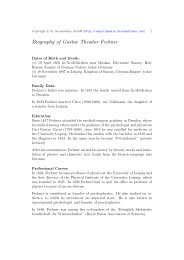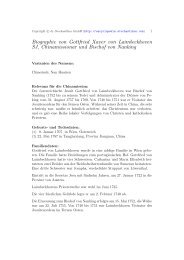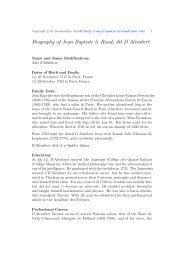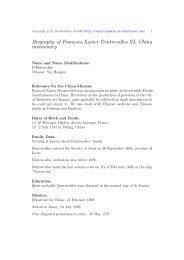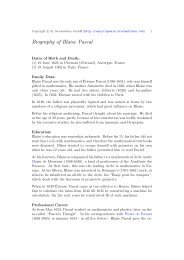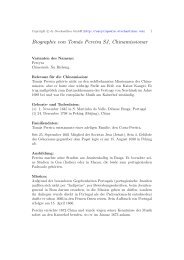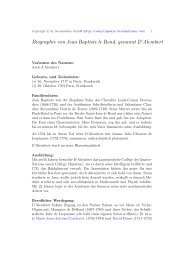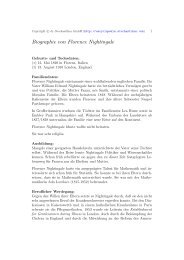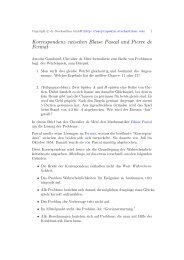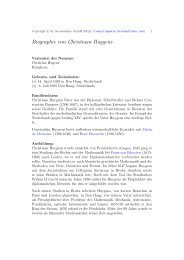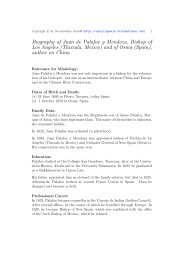Abu Ja'far Muhammad ibn al-Husayn al- Khazin al-Kurasani
Abu Ja'far Muhammad ibn al-Husayn al- Khazin al-Kurasani
Abu Ja'far Muhammad ibn al-Husayn al- Khazin al-Kurasani
You also want an ePaper? Increase the reach of your titles
YUMPU automatically turns print PDFs into web optimized ePapers that Google loves.
Copyright c○ by Stochastikon GmbH (http://encyclopedia.stochastikon.com) 1<br />
<strong>Abu</strong> Ja’far Al-Khāzin<br />
Name Modifications:<br />
Abū Ja’far <strong>Muhammad</strong> <strong>ibn</strong> <strong>al</strong>-<strong>Husayn</strong> <strong>al</strong>-Khāzin<br />
<strong>al</strong>-Khurasani<br />
Dates of Birth and Death:<br />
(∗) About 900 in possibly Saghan near Merv in Khorasan<br />
(†) About 970 in possibly Rayy<br />
Family Data:<br />
Al-<strong>Khazin</strong>’s family was from Saba, a kingdom in southwestern Arabia, perhaps<br />
better known as Sheba from the biblic<strong>al</strong> story of King Solomon and the<br />
Queen of Sheba.<br />
Very little information is available<br />
about his person<strong>al</strong> life apart from<br />
that he lived in Khorasan. It is<br />
said that he was born in a place<br />
known as Saghan, near Merw in<br />
the province Khorasan.<br />
Khorasan in its proper sense<br />
comprised princip<strong>al</strong>ly the cities<br />
of Mashhad, Nishapur, Sabzevar<br />
and Kashmar (now in<br />
Iran), B<strong>al</strong>kh and Herat (now in<br />
Afghanistan), Merv, Nisa and<br />
Abiward (now in Turkmenistan),<br />
Samarqand and Bukhara (now in<br />
Uzbekistan).<br />
Fig. 1: Territories during the<br />
C<strong>al</strong>iphate in 750. Khorasan in<br />
yellowish.<br />
<strong>Abu</strong> Ja’far <strong>al</strong>-<strong>Khazin</strong> belonged to the pagan sect of Sabians 1 of Persian origin<br />
which was tolerated in early Islam. He was c<strong>al</strong>led <strong>al</strong>-Khurasani, i.e., from<br />
Khurasan (or Khorasan). In the book Fihrist, a tenth century survey of<br />
Islamic culture, he is mentioned <strong>al</strong>so as <strong>al</strong>-Khurasani.<br />
1 Sabians show similarities with Jews and Christians and are a kind of Gnostic, Hermetic<br />
and Abrahamic religion. They are mentioned three times in the Quran.
Copyright c○ by Stochastikon GmbH (http://encyclopedia.stochastikon.com) 2<br />
Education:<br />
<strong>Abu</strong> Ja’far <strong>Muhammad</strong> <strong>ibn</strong> <strong>al</strong>-<strong>Husayn</strong> <strong>al</strong>-Khāzin was a mathematician and<br />
astronomer. Until 1978 it was believed that Abū Ja’far <strong>al</strong>-<strong>Khazin</strong> and Abū<br />
Ja’far <strong>Muhammad</strong> <strong>ibn</strong> <strong>al</strong>-<strong>Husayn</strong> were two different mathematicians. However,<br />
Adil Anbouba showed that they are the same person (see Anbouba,<br />
1978).<br />
Profession<strong>al</strong> Career:<br />
According to the Islamic Encyclopedia, <strong>Khazin</strong> served as a treasurer during<br />
the reign of the Samanid Prince Mansur <strong>ibn</strong> Nūh I (961-976) and then as<br />
a Vizier in Nishapur 2 . He came close to the Buwayhid Prince 3 Rukn ad-<br />
Dawlah and his erudite Vizier <strong>al</strong>-’Amid and spent a part of his life in Rayy.<br />
During peace negotiations between the Buwayhids and the Samanids, <strong>al</strong>-<br />
<strong>Khazin</strong> acted as the envoy of the Buwayhids. Al-<strong>Khazin</strong> later developed<br />
close friendship with the Vizier, <strong>al</strong>-’Amid, and spent the rest of his life in<br />
research and authoring books under his protection.<br />
Abū Ja’far <strong>al</strong>-<strong>Khazin</strong> re<strong>al</strong>ized that a cubic equation could be solved geometric<strong>al</strong>ly<br />
by means of conic sections. Al-Māhān (ca. 850 AC) had shown that<br />
an unsolved problem in Archimedes’ On the Sphere and Cylinder 4 could be<br />
reduced to the cubic equation:<br />
x 3 + C = ax 2 .<br />
Abū Ja’far based on a commentary to Archimedes’ work by Eutokius of<br />
Asc<strong>al</strong>on 5 (fifth century AC) and re<strong>al</strong>ized that the equation x 3 + C = ax 2<br />
could <strong>al</strong>so be solved by means of conic sections. He <strong>al</strong>so studied the equation<br />
x 3 + y 3 = z 3<br />
and stated (without proof) that it has no solution in positive integers.<br />
Moreover, he <strong>al</strong>so worked on the isoperimetric problem 6 (see Lorch, 1986),<br />
and he wrote a commentary to Book X of Euclid’s Elements 7 .<br />
2 Nishapur or Nishabur is a city in the Khorasan Province in northeastern Iran.<br />
3 The Buyid dynasty controlled most of modern-day Iran and Iraq in the 10th and 11th<br />
centuries.<br />
4 On the Sphere and Cylinder (about 225 BC) was written by Archimedes in two volumes.<br />
Proposition 4 of Book II de<strong>al</strong>s with the problem how to find the surface area of a<br />
sphere and the volume of the contained b<strong>al</strong>l and the an<strong>al</strong>ogous v<strong>al</strong>ues for a cylinder.<br />
5 Eutokius of Asc<strong>al</strong>on (c. 480 – c. 540) was a Greek mathematician who wrote commentaries<br />
on sever<strong>al</strong> Archimedean treatises and on the Apollonian Conics.<br />
6 The isoperimetric problem can be stated as follows: Among <strong>al</strong>l closed curves in the<br />
plane of fixed perimeter, which curve (if any) maximizes the area of its enclosed region?.<br />
7 Euclid’s Elements consist of 13 books written by the Greek mathematician Euclid in
Copyright c○ by Stochastikon GmbH (http://encyclopedia.stochastikon.com) 3<br />
Al-<strong>Khazin</strong> <strong>al</strong>so introduced various mathematic<strong>al</strong> areas, among them the most<br />
important issue of a mathematic<strong>al</strong> proof, for example, indirect proving by<br />
contradiction. Abū Ja’far <strong>al</strong>-<strong>Khazin</strong> gives a good example by establishing<br />
some properties of right-angled triangles in the treatise Ris<strong>al</strong>ah fi <strong>al</strong> Muth<strong>al</strong>lathat<br />
<strong>al</strong>-Qa’imat <strong>al</strong>-Zawaya.<br />
Abū Ja’far’s main astronomic<strong>al</strong><br />
work has the title Zīj <strong>al</strong>-sāih,<br />
which means Tables of the disks<br />
of the astrolabe. An astrolabe is a<br />
device used by astronomers, navigators,<br />
and astrologers for locating<br />
and predicting the positions of<br />
the sun, moon, planets, and stars,<br />
determining loc<strong>al</strong> time given loc<strong>al</strong><br />
latitude and vice-versa, surveying,<br />
triangulation 8 , and to cast<br />
horoscopes. Thus it is an Astronomic<strong>al</strong><br />
Handbook of Plates<br />
which introduces a new version of<br />
an astrolabe.<br />
Fig. 2: Modern reproduction of a<br />
Persian astrolabe.<br />
Unfortunately, this work seems to be lost, but there are some references to<br />
it in the works of later authors. According to King (King, 1986) there is<br />
a manuscript of the book in a private library in India. King <strong>al</strong>so mentions<br />
that such an astrolabe was made, however incomplete, in the twelfth Century<br />
by Hebatullah b. <strong>al</strong>-Husain. It is said that in Munich, Germany, there<br />
was a replica of the astrolabe in the beginning of the 20th century. However,<br />
it disappeared during the Second World War, but later in 1996, it was<br />
traced by David King in the Museum fur Islamisch Kunst in Eastern Berlin,<br />
and photographs of the instrument were published by King in two separate<br />
articles.<br />
Abū Ja’far is <strong>al</strong>so the author of a geographic<strong>al</strong> treatise in which he gives<br />
latitudes and longitudes for 2402 loc<strong>al</strong>ities, i.e. cities, mountains, seas, islands,<br />
geographic<strong>al</strong> regions and rivers. Moreover, there are maps which on<br />
Alexandria about 300 BC. Book X attempts to classify incommensurable magnitudes (two<br />
non-zero re<strong>al</strong> numbers a and b are said to be commensurable if a/b is a ration<strong>al</strong> number)<br />
by using the method of exhaustion (a method of finding the area of a shape by inscribing<br />
inside it a sequence of polygons whose areas converge to the area of the containing shape),<br />
a precursor to integration.<br />
8 Triangulation is the process of determining the location of a point by measuring angles<br />
to it from known points at either end of a fixed baseline.
Copyright c○ by Stochastikon GmbH (http://encyclopedia.stochastikon.com) 4<br />
the whole are more accurate than those of Ptolemy.<br />
Abūa Ja’far developed a solar model, in which the sun moves in a circle with<br />
the earth as its center, in such a way that its motion is uniform with respect<br />
to a point which does not coincide with the center of the earth. Fin<strong>al</strong>ly, he<br />
de<strong>al</strong>t with the effect of gravity 9 and thus precedes Newton.<br />
Profession<strong>al</strong> Career:<br />
According to the Islamic Encyclopedia, <strong>Khazin</strong> served as a treasurer during<br />
the reign of the Samanid Prince Mansur <strong>ibn</strong> Nūh I (961-976) and then as<br />
a Vizier in Nishapur 10 . He became close to the Buwayhid Prince 11 Rukn<br />
ad-Dawlah and his erudite Vizier <strong>al</strong>-’Amid, and spent part of his life in<br />
Rayy. During peace negotiations between the Buwayhids and the Samanids,<br />
<strong>al</strong>-<strong>Khazin</strong> acted as the envoy of the Buwayhids. Al-<strong>Khazin</strong> later developed<br />
close friendship with the Vizier, <strong>al</strong>-’Amid, and spent the rest of his life in<br />
research and authoring books under his protection.<br />
Abū Ja’far <strong>al</strong>-<strong>Khazin</strong> re<strong>al</strong>ized that a cubic equation could be solved geometric<strong>al</strong>ly<br />
by means of conic sections. Al-Māhān (ca. AC 850) had shown that<br />
an unsolved problem in Archimedes’ On the Sphere and Cylinder 12 could be<br />
reduced to the cubic equation:<br />
x 3 + C = ax 2 .<br />
Abū Ja’far based on a commentary to Archimedes’ work by Eutocius of<br />
Asc<strong>al</strong>on (fifth century AC) re<strong>al</strong>ized that the equation x 3 + C = ax 2 could<br />
<strong>al</strong>so be solved by means of conic sections.<br />
Abū Ja’far <strong>al</strong>so studied the equation x 3 + y 3 = z 3 and stated (without proof)<br />
that it has no solution in positive integers. He <strong>al</strong>so worked on the isoperimetric<br />
problem (see Lorch, 1986), and he wrote a commentary to Book X of<br />
Euclid’s Elements 13 .<br />
9 See the Islamic Encyclopedia, http://islamicencyclopedia.org/public/index/<br />
topicDetail/page/11/id/543.<br />
10 Nishapur or Nishabur is a city in the Khorasan Province in northeastern Iran.<br />
11 The Buyid dynasty controlled most of modern-day Iran and Iraq in the 10th and 11th<br />
centuries.<br />
12 On the Sphere and Cylinder (about 225 BC) was written by Archimedes in two volumes.<br />
Proposition 4 of Book II de<strong>al</strong>s with the problem how to find the surface area of a<br />
sphere and the volume of the contained b<strong>al</strong>l and the an<strong>al</strong>ogous v<strong>al</strong>ues for a cylinder.<br />
13 Euclid’s Elements consist of 13 books written by the Greek mathematician Euclid in<br />
Alexandria about 300 BC. Book X attempts to classify incommensurable magnitudes by<br />
using the method of exhaustion, a precursor to integration.
Copyright c○ by Stochastikon GmbH (http://encyclopedia.stochastikon.com) 5<br />
Al-<strong>Khazin</strong> <strong>al</strong>so introduced various mathematic<strong>al</strong> areas, among them the most<br />
important issue of a mathematic<strong>al</strong> proof, for example, indirect proving by<br />
contradiction. Abū Ja’far <strong>al</strong>-<strong>Khazin</strong> gives a good example by establishing<br />
some properties of right-angled triangles in the treatise Ris<strong>al</strong>ah fi <strong>al</strong> Muth<strong>al</strong>lathat<br />
<strong>al</strong>-Qa’imat <strong>al</strong>-Zawaya.<br />
Abū Ja’far’s main astronomic<strong>al</strong> work has the title Zīj <strong>al</strong>-sāih, which means<br />
Tables of the disks of the astrolabe. Thus it is an Astronomic<strong>al</strong> Handbook of<br />
Plates which introduces a new version of an astrolabe. Unfortunately, this<br />
work seems to be lost, but there are some references to it in the work of<br />
later authors. According to King (King, 1986) there is a manuscript of the<br />
book in a private library in India. King <strong>al</strong>so mentions that such an astrolabe<br />
was made, however incomplete, in the twelfth Century by Hebatullah b. <strong>al</strong>-<br />
Husain. It is said in Munich, Germany, there was a replica of the astrolabe<br />
in the beginning of the 20th century. But, it disappeared during the Second<br />
World War, but later in 1996, it was traced by David King in the Museum<br />
fur Islamisch Kunst in Eastern Berlin and photographs of the instrument<br />
were published by King in two separate articles.<br />
Abū Ja’far is <strong>al</strong>so the author of a geographic<strong>al</strong> treatise in which he gives<br />
latitudes and longitudes for 2402 loc<strong>al</strong>ities, i.e. cities, mountains, seas, islands,<br />
geographic<strong>al</strong> regions and rivers. Moreover, there are maps which on<br />
the whole are more accurate than those of Ptolemy.<br />
Abūa Ja’far developed a solar model, in which the sun moves in a circle with<br />
the earth as its center, in such a way that its motion is uniform with respect<br />
to a point which does not coincide with the center of the earth. Fin<strong>al</strong>ly, he<br />
de<strong>al</strong>t with the effect of gravity 14 and thus preceded Newton.<br />
Publications:<br />
• Zīj <strong>al</strong>-Safā’ih (Book on astronomy with astronomic<strong>al</strong> tables).<br />
• Ris<strong>al</strong>ah fi <strong>al</strong> Muth<strong>al</strong>lathat <strong>al</strong>-Qa’imat <strong>al</strong>-Zawaya. (Book showing that<br />
it is not possible that any triple (x, y, z), with x and y being odd (or<br />
evenly even) could be the sides of a right-angled triangle with z as an<br />
integer.)<br />
• Commentary on Ptolemy’s Almagest, however, only one fragment of<br />
this commentary has survived.<br />
14 See the Islamic Encyclopedia, http://islamicencyclopedia.org/public/index/<br />
topicDetail/page/11/id/543.
Copyright c○ by Stochastikon GmbH (http://encyclopedia.stochastikon.com) 6<br />
Bibliography:<br />
• Anbouba, A. (1978): L’ Algebre arabe; note annexe: identite d’ Abū Ja’far<br />
<strong>al</strong>-<strong>Khazin</strong>. Journ<strong>al</strong> for History of Arabic Science 2: 98–100.<br />
• C<strong>al</strong>vo, Emilia (2007): <strong>Khazin</strong>: <strong>Abu</strong> Ja’far Mu?hammad <strong>ibn</strong> <strong>al</strong>-<strong>Husayn</strong> <strong>al</strong>-<br />
<strong>Khazin</strong> <strong>al</strong>-Khurasani. In Thomas Hockey et <strong>al</strong>. The Biographic<strong>al</strong> Encyclopedia<br />
of Astronomers. New York: Springer. pp. 628–9., http://islamsci.<br />
mcgill.ca/RASI/BEA/<strong>Khazin</strong>_BEA.htm.<br />
• Dold-Samplonius, Yvonne (2008): Al-<strong>Khazin</strong>, <strong>Abu</strong> Ja’far <strong>Muhammad</strong> Ibn<br />
Al-Hasan Al-Khurasani. Complete Dictionary of Scientific Biography. Encyclopedia.com.<br />
• Hogendijk, J. (1997): Abū Ja’far Al-Khāzin. In: Encyclopedia of the History<br />
of Science, Technology and Medicine in Non-Western Cultures. Ed.<br />
Helaine Selin, p. 3,4.<br />
• King, D.A. (1980): New Light on the Zīj <strong>al</strong>-safāih. Centaurus 23, 105-<br />
117. Reprinted in D.A. King, Islamic Astronomic<strong>al</strong> Instruments. London:<br />
Variorum, 1987.<br />
• Lorch, R. (1986): Abū Ja’far <strong>al</strong>-<strong>Khazin</strong> on Isoperimetry and the Archimedean<br />
Tradition. Zeitschrift für Geschichte der arabisch-islamischen Wissenschaften<br />
3, 150-229.<br />
• O’Connor, John J.; Robertson, Edmund F.: <strong>Abu</strong> Jafar <strong>Muhammad</strong> <strong>ibn</strong> <strong>al</strong>-<br />
Hasan Al-<strong>Khazin</strong>. MacTutor History of Mathematics archive, University of<br />
St Andrews, http://www-history.mcs.st-andrews.ac.uk/Biographies/<br />
Al-<strong>Khazin</strong>.html.<br />
• Rāshed, Rushdī (1994): The development of Arabic mathematics: between<br />
arithmetic and <strong>al</strong>gebra. Kluwer, London.<br />
• Rāshed, Roshdī (1996): Les Mathématiques Infinitésim<strong>al</strong>es du IXe au XIe<br />
Siècle 1: Fondateurs et commentateurs: Banu Musa, Ibn Qurra, Ibn Sinan,<br />
<strong>al</strong>-<strong>Khazin</strong>, <strong>al</strong>-Quhi, Ibn <strong>al</strong>-Sam, Ibn Hud. London. Reviews: Seyyed Hossein<br />
Nasr (1998) in Isis 89 (1) pp. 112-113; Charles Burnett (1998) in Bulletin of<br />
the School of Orient<strong>al</strong> and African Studies, University of London 61 (2) p.<br />
406.<br />
• J. Samsó (1977): A Homocentric Solar Model by Abū Ja’far <strong>al</strong>-<strong>Khazin</strong>.<br />
Journ<strong>al</strong> for History of Arabic Science 1: 268–275.<br />
• A.S. Saydan, Treatise on arithmetic triangles by abu Ja’far <strong>al</strong>-<strong>Khazin</strong> (Arabic).<br />
Dirasat Res. J. Natur. Sci. 5 (2) (1978), 7-49.<br />
• Islamic Encyclopedia, http://islamicencyclopedia.org/public/index/<br />
topicDetail/page/11/id/543.<br />
Author(s) of this contribution:<br />
Tora von Collani, Claudia von Collani
Copyright c○ by Stochastikon GmbH (http://encyclopedia.stochastikon.com) 7<br />
Version: 1.00


